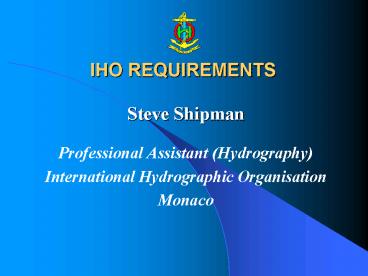IHO REQUIREMENTS - PowerPoint PPT Presentation
1 / 31
Title: IHO REQUIREMENTS
1
IHO REQUIREMENTS
- Steve Shipman
- Professional Assistant (Hydrography)
- International Hydrographic Organisation
- Monaco
2
Safety of Navigation
- Conduct surveys and publish charts
- Publish tide-tables
- Issue Maritime Safety Information
3
The Vertical Dimension 1
- A datum level is required
- Mean Sea Level?
- Hydrographers driven by safety of navigation
- Low water datum (Chart Datum)
4
The Vertical Dimension 2
- The IHO has resolved (TR A2.5) that
- Lowest Astronomical Tide (LAT) should normally be
used for Chart Datum.
LAT is defined as the lowest tide level which can
be predicted to occur under average
meteorological conditions and under any
combination of astronomical conditions. It is
recommended that LAT be calculated either over a
minimum period of 19 years using harmonic
constants derived from a minimum of one years
observations or by other proven methods known to
give reliable results. Tide levels should, if
feasible, reflect the estimated error values
obtained during the determination of these levels
5
Chart Datum / LAT
6
The Vertical Dimension 3
- Safety of Navigation also requires that there is
a High Water Datum - Clearance heights of bridges and power cables are
referenced to this High Water Datum - The IHO has resolved that Highest Astronomical
Tide (HAT) should be used - HAT has a similar definition to LAT
- Relevant for flood evaluation
7
High Water Datum
8
Variation in Datum 1
- MSL
- a relatively small / slow variation both
spatially and temporally - LAT and HAT
- Significant spatial variation
- Also temporal variation in time of high / low
water across medium to small scale charts
9
Variation in Datum 2
- Reasons for the variation in the range of tide
include - Seabed topography
- Water body resonance
- Coriolis
10
Spring Tidal Ranges
11
Variation in Datum 3
- Datum will vary across all but large scale
charts - Need to model this variation in datum
- The co-tidal chart or model
12
Variation in Datum 4
- The Co-tidal model usually describes
- Variation in range of tide
- Variation in time of tide
- The model may need to allow for
- Variation between High and Low water
- Variation with the Spring / Neap cycle
13
Requirements
- Data to populate the co-tidal model
- Density relative to variation
- A lack of offshore data
14
Tidal Data
- Publication S-44IHO Standards for Hydrographic
Surveys - Tidal heights should be observed so that the
total measurement error at the tide gauge,
including timing error, does not exceed /- 5 cm
at 95 for Special Order surveys. For other
surveys /- 10 cm should not be exceeded. - Special Order surveys - Harbours, berthing
areas, and associated critical channels with
minimum under keel clearances
15
Charts
- Paper
- Raster Navigation Charts
- Electronic Navigation Charts (ENCs)
16
Tides
- Predicted
- Real
17
Printed Tide-tables
18
(No Transcript)
19
UKHO EasyTide Example
20
Predicted Tides
- Quality depends on data available for analysis
- Publication S-44IHO Standards for Hydrographic
Surveys - providing data for tidal analysis and subsequent
prediction, for which purposes the observations
should extend over the longest possible period
and not less than 29 days
21
Predicted v Real
- Predicted tides do not account for Meteorological
Factors. - In critical situations real time tidal
information is required or at least information
on variation from predicted.
22
Tidal Warnings
- Issued as part of Maritime Safety Information
(MSI) - Local and Regional Warnings
- Vessel Traffic Services
- Possible inclusion in AIS
23
(No Transcript)
24
Seamless Vertical Reference 1
- RTK GPS now allows the conduct of hydrographic
surveys without any requirement to measure tides!
25
(No Transcript)
26
Seamless Vertical Reference 2
- We have removed one problem and introduced a
new one! - No need to measure tides -therefore no need for
a co-tidal chart - But we now needa spheroid chart datum model
27
Seamless Vertical Reference 3
- There is a lot of work going on in the geodetic
community to determine a seamless vertical
reference - A MSL / Geoidal surface would appear to be
preferred - The maritime community might prefer an
ellipsoidal reference?
28
Seamless Vertical Reference 4
- The geodetic community want a model at the
sub-centimetre level - The maritime community, in general, is interested
at the decimetre level although there are always
some special cases with higher requirements
29
Conclusions 1
- More data collection for longer periods in order
to have better predictions - Greater provision of real time tides / variation
from predicted particularly in restricted areas - Greater variety of delivery mechanisms with
integrity checking
30
Conclusions 2
- Increasingly integrated in VTS
- All referenced to a global vertical reference
- IALA are also developing a Risk Management
Model for assessing amongst other things the
likelihood of groundings, this requires a tidal
statistical input
31
Conclusions 3
- MUST NOT FORGET
- The horizontal movement of the water mass is also
of great importance to Safety of Navigation































